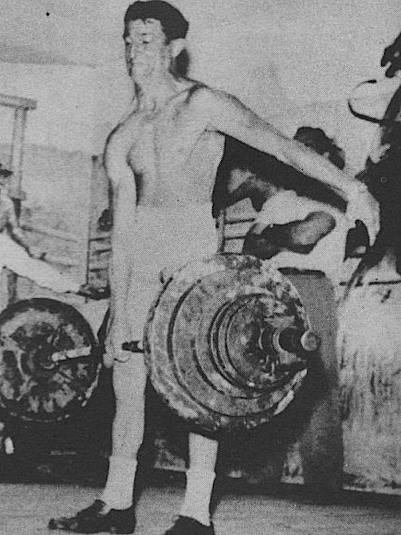The deadlift has grown in popularity over the years. In fact, probably because of powerlifting more than anything else, it is one of the most recognisable lifts there is. And this is all for good reason, as it is a foundational exercise that is one of the best for building all-around strength.
However, as popular as the deadlift has become, just about every other version of it, except maybe the sumo deadlift, has declined in popularity. In a previous article, I covered one of my favorite variations, the Jefferson deadlift – and now we focus on another, the one-hand deadlift.
Me demonstrating the suitcase-style one-hand deadlift.
How to Do It
The one-hand deadlift used to be trained much more often. In fact, it comprised two of the lifts (done right- and left-handed) in the British Amateur Weight Lifting Association (BAWLA) for many years.
William Pullum, the 1991 BAWLA champion, gave instructions on this lift in one of his books, How to Use a Barbell:
[T]his feat may be performed with the barbell held either at right angles or parallel to the lifter’s front. Of the two, the former is the most favoured style, as it seems to possess the greater possibilities. Whichever method is employed, this is the procedure to follow:
The feet should be set comfortably apart, the disengaged hand placed just above the knee as first advised in the “Swing,” the back kept as straight as can be, and the legs made to do most of the work. To be counted a correctly finished effort, the bell has to be brought to at least the height of the lifter’s knees and held there for the prescribed period. While so held, the bar must be kept level and the legs be maintained straight. In “bell parallel to the lifter’s front” style, the bar is grasped with the knuckles forward.
Thus we have two variations we can work with – barbell to the side or front. The barbell to your side, running perpendicular to your body, has also been called the suitcase deadlift. In that variation, your abdominals, obliques, and all other muscles of the torso must work to support your body as the weight is all on one side. But you can generally lift more this way because the body can be shifted slightly to one side.
“The barbell is the ultimate tool for this lift as it allows you to go to higher and higher poundages, but you can certainly get started with kettlebells or dumbbells.”
If you’ve never tried one-hand deadlifting before, the hard part at first can be gripping the bar in a balanced way so it doesn’t come out of your hand. For most people, the grip is going to be the weak link, thus this is a great hand-training exercise.
Single-hand deadlifting can also be done with a number of other tools. It is often done with a shorter range of motion, making it more of a partial lift.
An Impressive History
Just how far can this exercise be taken? I believe Hermann Goerner’s record still exists. It’s even posted on the Guinness World Records website. Edgar Mueller reported in the book, Goerner the Mighty, regarding his unofficial and official records in this lift:
On this lift Hermann has lifted more weight than any other man in the world. His best performances being 727.5 lb. (330 kilos), which was lifted unofficially on 8th October, 1920, in Leipzig. The bar was correctly lifted from the floor to the fully erect position of the body. Officially Hermann has performed a right-hand dead lift with a barbell of 663.5 lb. (301 kilos), which was lifted on 29th October, 1920, in Leipzig. No other man has come within aiming distance of Hermann’s amazing record.
Here is Peter Cortese with a triple bodyweight one-hand deadlift performed back in the 1950s:

Variations
This lift can also be changed up slightly for different focuses on hand strength.
- Thick bar
- Hook grip
- Thumbless grip
The barbell is the ultimate tool for this lift as it allows you to go to higher and higher poundages, but you can certainly get started with kettlebells or dumbbells.
Because of the balance involved with a barbell, this movement is best done for low reps, no more than five. Generally, I keep the sets to three or fewer per hand. I recommend trying to work both hands somewhat evenly, but you’ll likely find your dominant hand is much stronger in this exercise. This is a great exercise to work in before or after any two-hand deadlifting sessions.
More Like This:
- 15 Practical Strategies to Increase Your Deadlift Max
- 14 Strongman Articles to Strengthen Your Knowledge
- 33 Reasons to Train Strongman
- New on Breaking Muscle UK Today
References:
1. W.A. Pullum, How to Use a Barbell, South Carolina: Strongman Books, pg. 66-67. 2012.
2. Edgar Mueller, Goerner the Mighty, South Carolina: Strongman Books, p. 59. 2012.
Photo 1 courtesy of Logan Christopher.






